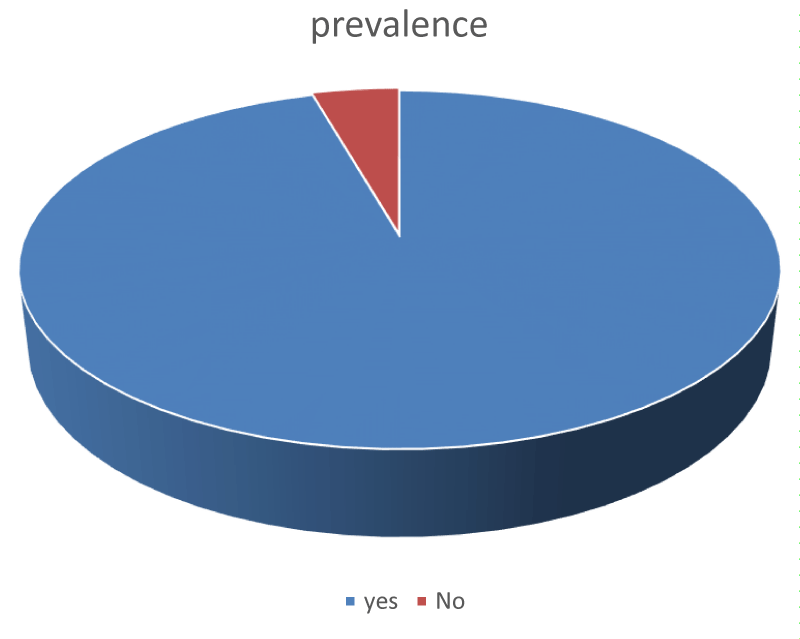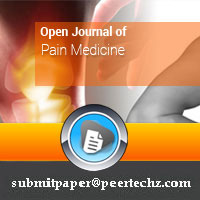Open Journal of Pain Medicine
Prevalence of low back pain among the Dentists of Karachi, Pakistan
Sonum Sachdev1, Vikash Chughani2, Mukesh kumar3 & Aadil Ameer Ali2*
2Lecturer, Institute of Physiotherapy & Rehabilitation sciences, Shaheed Mohtarma Benazir Bhutto Medical University, Larkana, Pakistan
3Deputy Director, Institute of Physiotherapy & Rehabilitation sciences, Shaheed Mohtarma Benazir Bhutto Medical University, Larkana, Pakistan
Cite this as
Sachdev S, Chughani V, kumar M, Ali AA (2021) Prevalence of low back pain among the Dentists of Karachi, Pakistan. Open J Pain Med 5(1): 020-023. DOI: 10.17352/ojpm.000026Objective: To assess the Prevalence of Low Back Pain among the Dentists of Karachi, Pakistan
Methodology: A cross sectional survey was conducted in many different hospitals of Karachi, Pakistan from October to December 2015. A self-constructed questionnaire which includes the demographic Characterstics and other questions were duration of work per day, work experience of a participants, onset of pain, aggravating factors. Among the 68 dentists SPSS version 17 was used to analyze the data.
Results: The majority (n=38, 55.8%) of the participants belongs to age group of 36 to 45 years, (n=36, 52.9%) were female and (n=25, 36.7%) were specialized in the dental surgery. Moreover in the prevalence the (n=65, 96 %%) of the participants reported they are suffering from lower back pain. After checking the working status of respondents we found that (n= 34, 52.3%) were working more than 8 hours in a day, while (n=29, 44.6%) of responded that they had work experience between 5 to 10 years. In the onset of pain (n=23, 35.3%) reported that they usually start feeling pain within 1 to 2 hours of working especially when they use to bend their lower back.
Conclusion: This Study finalized that there is 96% prevalence of lower back pain among the dentists working in Karachi Pakistan.
Introduction
Globally Low Back Pain (LBP) is the most general complaint especially in Dentists. Almost every dentist experiences the LBP in their life and they are prone to have low back pain due to their activity in sustained sitting posture, whereas, the LBP decreases their work performance as well. The low back pain can be localized or radiating, in advance cases it affects the lower limb weakness which can lead to an abnormal gait [1,2]. The prevalence of LBP is 44.9% globally, whereas in Pakistan it’s reported that 56% of dentist suffer from LBP. The Risk factors for Low back pain could be non-modifiable and modifiable [3.4]. The modifiable risk factors occupation-related such as, poor posture, activity in sustain postures and lifting of heavy loads Whereas the non-modifiable factors are age, past history of Low back pain, the changeable factors include an inactive lifestyle, obesity, and smoking [5,6]. The LBP is managed by the different methods depending upon the norms and culture of that area but the common methods which are being used are the pharmacological management along with the support of physical therapy management. In pharmacological management the Non-Steroidal Anti-Inflammatory Drugs (NSAIDs) are widely used whereas in the physical therapy the Transcutaneous Electrical Nerve Stimulation (TENS), Inferential therapy, Ultrasound (US) spinal manipulation, McKenzie exercises, exercises for spinal flexibility, thermotherapy(cold/hot packs).acupuncture, massage therapy, acupressure are used to treat the different painful conditions which causes the LBP [7,8].
Material and methods
Study design, settings and duration
A cross sectional descriptive study was conducted from October to December 2015, and data was collected different dental OPDs of Karachi, dental OPDs of the following institutes: Jinnah Postgraduate Medical Centre (JPMC), Civil Hospital Karachi, Dr Ishrat Ul Bad Khan Institute of Oral Health Sciences, Dow dental OPD DMC & Ojha campus Karachi, Pakistan.
Sampling
Convenient Non-Probability Sampling Technique among the 68 selected participants were used. Participants with both genders (male & female), having the age between 25- to 45 years and willing to participate were included in the study. While, participant above the age of 45 years, pregnant females, participant having any systematic disease, having history of trauma and not willing to sign inform consent were excluded.
Data collection tool
A self-constructed proforma was used to collect the data, which include the demographic Characterstics (age, gender and their field of specialization). While the other questions were duration of work per day, work experience of a participants, onset of pain, aggravating factors of pain.
Data collection procedure
The participants were asked to fill the questionnaire on the spot, only the minor help were given upon the request of participants in order to understand the questionnaire.
Data analysis procedure
Descriptive statistics; categorical variables were measured as frequency and percentage. The Data was analyzed by using Statistical Package for Social Sciences (SPSS) version 17.
Ethical concern
As the Ethical approval was taken from the Review Committee of Institute of Physical Medicine & Rehabilitation, Dow University of health sciences and for data collection prior permission was taken from the respective head of the departments. Informed consent was taken from the participants prior to the data collection that their participation is voluntary, information of their responses will be kept confidential and they can leave the study anytime they want.
Results
Table 1 displays demographic characteristics of participants which shows that Majority (n=38, 55.8%) of the participants belongs to age group of 36 to 45 years and (n=36, 52.9%) were females. In the domain of the Speciality majority (n=25, 36.7%) were practicing in the department of dental surgery.
Figure 1 displays the prevalence of lower back pain which shows that (n=65, 95.5%) of the respondents reported that they are suffering from lower back pain.
Table 2 shows working status of participants which shows that Majority (n=34, 52.3%) of the participants were working more than 8 hours in a day, whereas the (n=29, 44.6%) had work experience of 5 to 10 years.
Table 3 shows status of pain of participants which shows that Majority (n=23, 35.3%) of the participants were experiencing a pain after the 3 to 5 hours of working, however in (n=29, 44.6%) respondents pain was aggravating when they were bending their lower back.
Discussion
The current study disclosed that there is 96% of prevalence among the dentists who are working in Karachi, Pakistan. Globally there were many studies conducted and some of them are in line with the current study that are conducted by Leggat PA et al in Queensland Australia and concluded that the dentists who are working in different hospital are more prone to suffer from lower back pain due to their posture adaptation. When the dentists were applying different procedure on patients they don’t take care of their own posture and due to continuous non maintenance of the posture slowly they start developing the lower back pain [9,10]. Similar studies were conducted by Ilyas M et al in 2012 in Indonesia and Pargali et al in 2010 in Iran, concluded that there is only 9.3% prevalence of lower back pain among the working dentists of Indonesia where as in Iran its higher and found around 55%. The main cause of the lower back pain among the dentists is their abnormal posture, prolong sitting, prolong standing and these all positions are maintained by the dentists for prolong time without any break. Among all, the dentist who were working in the surgical department were found more prone to the lower back pain which can be due to the prolong standing. The dentists who work in surgical department the used to do the extraction which requires the prolong standing [6,11]. The factors which aggravates the pain in the dentists of Pakistan is improper bending of lower back which is usually performed by the dentists at their working places [12,13]. Globally it was observed that the dentist’s starts felling pain when they work more than 5 hour per day continuously but in Pakistan we found that the dentists start feeling lower back pain after the working of 1 to 2 hours which shows the poor health of the lower back among dentists [14,15].
Conclusion
The study concluded that the Dentist who were working in different hospitals of Karachi Pakistan were 96% prone to develop the lower back pain, however the onset of pain and the aggravating factors among all were different and were mainly dependent of the duration of work performed by them on daily basis.
Limitations
As this study was conducted in the hospitals of Karachi which cannot show the full aspect of pain among the dentist.
Author contributions
All authors contributed equally.
We acknowledge the support of Dentists who have participated in this study.
- Al Wassan K, Almas K, Al Shethri SE, Al-Qahtani MQ (2001) Back & neck problems among dentists and dental auxiliaries. J Contemp Dent Pract 2: 17-30. Link: https://bit.ly/3mCKyvE
- Taguchi TJ (2003) Low back pain in young and middle-aged people. JMAJ 46: 417-423. Link: https://bit.ly/3ziAM5t
- Alexopoulos EC, Stathi IC, Charizani FJB (2004) Prevalence of musculoskeletal disorders in dentists. BMC Musculoskelet Disord 5: 16. Link: https://bit.ly/38coWOr
- Falavigna A, Teles AR, Mazzocchin T, de Braga GL, Kleber FD, et al. (2011) Increased prevalence of low back pain among physiotherapy students compared to medical students. Eur Spine J 20: 500-505. Link: https://bit.ly/3sPAOiY
- Ali AA, Haq N, Hussain A, Rafique M, MR MI, et al. (2021) Assessment of Frequent Work Related Musculoskeletal Disorders in Patients Visiting the Physiothrapy OPD of Civil Hospital Quetta, Pakistan: A Cross Sectional Survey. Indian Journal of Physiotherapy and Occupational Therapy - An International Journal 15: 91. Link: https://bit.ly/3eMFD6J
- Pargali N, Jowkar NJ (2010) Prevalence of musculoskeletal pain among dentists in Shiraz, Southern Iran. Int J Occup Environ Med 1: 69-74. Link: https://bit.ly/3yi1ABz
- Chou R, Qaseem A, Snow V, Casey D, Cross JT, et al. (2007) Diagnosis and treatment of low back pain: a joint clinical practice guideline from the American College of Physicians and the American Pain Society. Ann Intern Med 147: 478-491. Link: https://bit.ly/38f7YyM
- Douglass AB, Bope ET (2004) Evaluation and treatment of posterior neck pain in family practice. 17: S13-S22. J Am Board Fam Pract 17: S13-S22. Link: https://bit.ly/3jgyrSQ
- Leggat P, Smith DJ (2006) Musculoskeletal disorders self‐reported by dentists in Queensland, Australia. Aust Dent J 51: 324-327. Link: https://bit.ly/3DjpK2g
- Valachi B, Valachi KJ (2003) Mechanisms leading to musculoskeletal disorders in dentistry. J Am Dent Assoc 134: 1344-1350. Link: https://bit.ly/3zpVwZe
- Ilyas M, Dharmaji TP, Journal D (2012) Low Back Pain in dentists of Indonesia. Pakistan Oral & Dental Journal 32. Link: https://bit.ly/3muZSdP
- Guo HR, Tanaka S, Halperin WE, Cameron LL (1999) Back pain prevalence in US industry and estimates of lost workdays. Am J Public Health 89: 1029-1035. Link: https://bit.ly/3DlZzrB
- Samat RA, Shafei MN, Yaacob NA, Yusoff AJ (2011) Prevalence and associated factors of back pain among dental personnel in North-Eastern State of Malaysia. International Journal of Collaborative Research on Internal Medicine & Public Health 3. Link: https://bit.ly/3ykEl9M
- Ali AA, Haq N, Hussain A, Rafique M, MR MI, et al. (2021) Assesment of Neck Pain Causes and Its Intensity among the Students of Department of Eastern Medicine, University of Balochistan, Quetta, Pakistan. Indian Journal of Physiotherapy & Occupational Therapy 15: 78. Link: https://bit.ly/3mAzKhE
- Vindigni D, Parkinson L, Walker B, Rivett DA, Blunden S, et al. (2005) A community‐based sports massage course for Aboriginal health workers. Aust J Rural Health 13: 111-115. Link: https://bit.ly/2XY7YBv
Article Alerts
Subscribe to our articles alerts and stay tuned.
 This work is licensed under a Creative Commons Attribution 4.0 International License.
This work is licensed under a Creative Commons Attribution 4.0 International License.


 Save to Mendeley
Save to Mendeley
